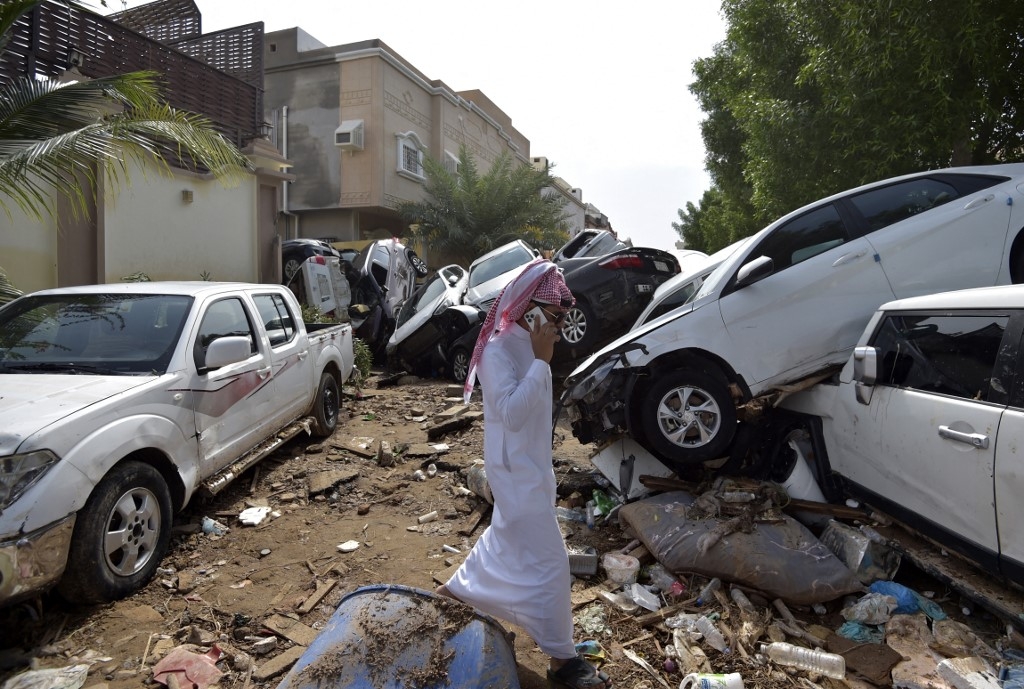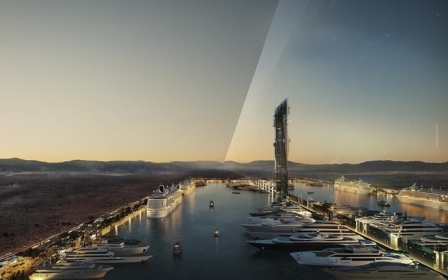Jeddah flood: Streets turn into scrap yards as residents count losses

Sajin Saleem was returning home to Saudi Arabia’s Jeddah from Qatar where he was attending a World Cup match.
Arriving at King Abdulaziz Airport as heavy rain flooded the coastal city on Thursday, he waited for hours to get a taxi but to no avail.
In the end, he was given a ride by another traveller driving back from the airport, who dropped Saleem off 6km from his home as the car couldn’t drive further due to the high water levels.
Wading through knee-deep water and carrying his luggage over his head, Saleem finally made it home.
No damage was caused by the floodwater to his fifth-floor flat, but his brand-new Chinese-made Changan car, parked on the ground floor, was submerged in mud that filled it up to the steering wheel.
New MEE newsletter: Jerusalem Dispatch
Sign up to get the latest insights and analysis on Israel-Palestine, alongside Turkey Unpacked and other MEE newsletters
As Jeddah residents slowly recover from the record flash flood - which resulted from 179 millimetres of rainfall - many like Saleem are struggling to get their vehicles up and running again in a city that has no effective public transport system.
The devastating flash floods on Thursday left two people dead and a scene of widespread damage to public properties and vehicles.
Footage shared on social media showed hundreds of cars floating, ramming into others, drowning in caved-in roads, and getting their engines and interiors smeared with thick mud.
While figures on the damage have not been announced yet, a 2015 study on two similar, previous floods in November 2009 and January 2011 found that more than 10,000 homes and 17,000 vehicles had been devastated by the two events combined.
Migrant workers hit hardest
After dawn on Thursday, warehouse supervisor Shaji Parappanadan set off for work in Kumra in south Jeddah from his residence in the al-Sharafiyah district.
"The weather was cloudy, and then it rained. I thought I wouldn’t make it to work, but I did," Parappanadan told Middle East Eye.
After a brief lull, it rained heavily again, and at around 1:30 pm local time, his manager told him to ride back home in the company’s Toyota Dyna as his small car might drown.
"It took three hours, as vehicles moved slowly, anticipating cave-ins on the road as we saw submerged trailers on the way," he said.
Early shift workers had reached their offices before their managers told them to work from home, and they were stuck in offices as they couldn’t risk taking their cars.
"Late-goers stuck on the road on their way to work. Some workers didn’t reach their residences even after midnight. Many workers slept in their warehouses," Parappanadan explained.
'Some workers didn’t reach their residences even after midnight. Many workers slept in their warehouses'
- Shaji Parappanadan, Jeddah resident
The floods hit migrant workers the hardest, who mostly rely on small cars for transport and restaurants for food.
Ishaq Poondoly, another ex-pat, said many workers who depended on eateries went hungry throughout the day at their lodgings or underpasses.
The next morning, authorities began working on clearing piled-up vehicles on the streets and opening roads.
An issue that dwells in many residents’ minds now is compensation and car insurance.
Many in Saudi Arabia, especially young professionals and ex-pats, prefer used cars as they are more affordable.
Several people who spoke to MEE said most residents with used cars have no hope that their vehicle repairs will be covered by insurance, as insurance policies tend to favour owners of new cars.
On Friday, the spokesman for Saudi insurance companies, Adel Al-Essa, addressed the concerns around the policy, confirming that compensation would be paid for damage caused by natural disasters, including rain.
Later the same day, Jeddah's municipal authorities announced a compensation scheme for those who suffered damages in the floods.
Repeated tragedies
Jeddah, a city of roughly four million people located close to the Red Sea, is often referred to as the "gateway to Mecca", where millions perform the Hajj and Umrah pilgrimages each year.
Winter rainstorms and flooding occur almost every year in Jeddah, where residents have long decried poor infrastructure. Floods killed 123 people in the city in 2009.
In November 2017, Jeddah police received 11,000 calls in one morning following heavy downpours in the city.
Last year, a plunge in temperatures in Saudi Arabia also resulted in floods in many parts of Jeddah.
Flash floods have caused problems in Jeddah for decades, going as back as the early 1970s, according to a 2015 study published in the Geomatics, Natural Hazards and Risk journal.
Heavy rainfalls occurred in 1972, 1977, 1979, 1992, and 1996, though the heaviest occurred in November 2009 and January 2011.
"These events were characterised by rainfall precipitation values of 70 and 111 mm, respectively," the study says.
The average flash flood damage that hit the Jeddah area in 2009 and 2011 was approximately 10 billion Saudi Riyals ($2.6bn).
The study said the geomorphological features of Jeddah, climate change, and unplanned urban development were the main reason for the repeated issue and predicted it would continue to happen in the future.
"The climatic changes have a major impact on the rainfall intensity and will appear more in the future."
Middle East Eye delivers independent and unrivalled coverage and analysis of the Middle East, North Africa and beyond. To learn more about republishing this content and the associated fees, please fill out this form. More about MEE can be found here.






